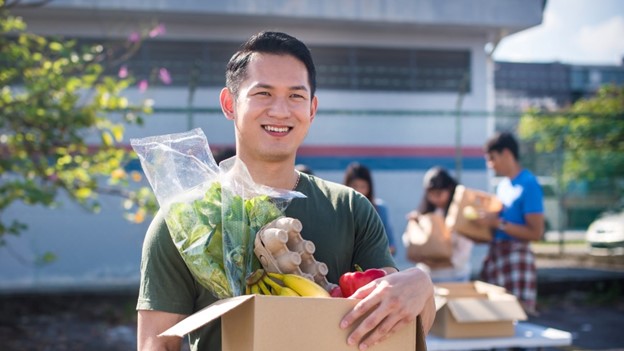Introduction
According to the Global Hunger Index(n.d.), Sri Lanka ranks 56 out of 127 countries, with a score of 11.3. This indicates a moderate level of hunger and highlights an opportunity to address food insecurity.
Sri Lankan supermarkets are estimated to cause around 25 per cent of the solid waste in urban areas, underscoring the retail sector’s role in managing and reducing food waste (Reitemeier et al., 2021). Aheeyar et al. (2023) highlighted that food waste is between 50% and 76% of the municipal solid waste handled by local authorities. However, despite these high numbers, the issue has not received the attention it deserves. One primary reason is the lack of clear responsibility and coordination when managing food waste. On top of that, weak regulations and limited government policies make the problem worse. Instead of tackling the root causes of food waste, most government efforts focus on food safety tasks, including checking expiration dates or taking legal action split between departments such as Public Health and Veterinary Services. (Reitemeier et al., 2021).
Although food waste levels are high, Reitemeier et al. (2021) point out that managing food waste is still a relatively new and emerging trend in Sri Lanka. As a result, no national strategy or official plan has yet been implemented to tackle the issue. However, interest in food waste management is steadily growing.
This article is based on a Master thesis written by Kanchan Randesh Wickrama Arachchi and supervised by Anna-Kaisa Saari. Full thesis can be found from: https://urn.fi/URN:NBN:fi:amk-2025061022040.
Challenges Sri Lanka Faces in Managing Food Waste
Most food businesses seek to sell their inventory, yet a significant amount of edible food still ends up in landfills. Common strategies like discounts and promotions (e.g., “buy one get one free”) are employed to reduce waste as products near their expiration dates. However, these efforts are often ineffective due to public attitude. Many Sri Lankans believe that food close to its expiration date is unsafe for consumption.
Additionally, several barriers hinder the redistribution of surplus food. These include a lack of awareness and motivation within donor organisations, operational constraints, legal and social concerns, and poor coordination among stakeholders. Many food businesses are profit-driven and operate with limited resources, making them hesitant to engage in surplus food redistribution due to their incapability to manage post-donation logistics, including donation tracking, transportation, or assuring food safety compliance. On top of that, concerns about legal liability, social backlash, or reputational damage, especially if donated food spoils or causes harm, can further discourage donations.
The Role of Digital Platforms in Surplus Food Redistribution
Digital platforms can play a transformative role in managing food waste, especially by enhancing surplus food redistribution. A significant challenge is the lack of coordination among stakeholders. Also donor organisations often lack confidence in handing food to unverified third parties and are reluctant to manage recipient selection. This study introduced No2Scrap, a cloud-based, mobile-optimised software application, which enables organisations seeking food donations to submit their needs as requests, while food enterprises can submit surplus food as donations. The system matches these inputs and helps bridge the coordination gap, enhancing the redistribution process with the involvement of community volunteers. A structured digital platform simplifies this process, ensuring safety, accountability, and ease of use.
With designated roles like system coordinators, the developed tool offers better control and transparency. Coordinators can manage logistics, monitor transactions, and generate necessary reports to maintain oversight. Additionally, social media can increase public awareness about the benefits of surplus food redistribution, helping to shift public attitudes and build new social norms. The system can also facilitate community engagement and ensure timely food delivery.
The government must play an essential role in this process. Addressing food waste requires introducing transparent policies, financial incentives (such as grants and tax breaks), and penalties for non-compliance. Moreover, awareness campaigns, training programs for food businesses, and school education initiatives can support a more sustainable food system.
Strategies for Scaling and Sustaining Surplus Food Redistribution in Developing Countries
In many developing nations, one of the primary challenges to effective food waste management is a widespread lack of awareness. This often translates into low public motivation to take meaningful action. Raising awareness, therefore, becomes the critical first step toward driving change and encouraging responsible food consumption and waste practices.
However, awareness alone is not enough. Government intervention is essential to reinforce efforts through well-defined regulations and consistently enforcing penalties for non-compliance. Clear policies can establish a framework that ensures accountability across the food supply chain.
Equally important is strong coordination among all stakeholders including producers, distributors, NGOs, and local communities. Establishing a central authority or dedicated organisation to oversee surplus food redistribution can significantly improve efficiency and transparency. This centralised body can streamline logistics, monitor impact, and ensure equitable food allocation.
As awareness grows and systems become more organised, surplus food redistribution efforts are more likely to scale effectively and be sustained over time. By combining public education, policy enforcement, and coordinated infrastructure, developing countries can make meaningful progress in reducing food waste and addressing food insecurity.
Conclusion
Surplus food redistribution in Sri Lanka holds great potential to combat food waste and food insecurity, but it requires urgent, coordinated action. Integrating digital platforms like the developed No2Scrap application, targeted policy reform, public awareness campaigns, and stronger stakeholder collaboration can bridge critical gaps in the current system. By aligning technology with transparent government regulation and community engagement, Sri Lanka can build a more resilient and sustainable food system that reduces waste and ensures that surplus food reaches those who need it most.

